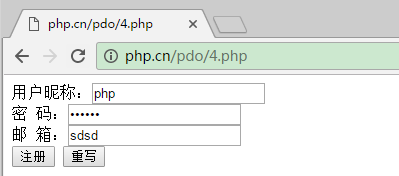10 recommended articles about php pdo
PDO::prepare — Prepare the SQL statement to be executed and return a PDOStatement object (PHP 5 >= 5.1.0, PECL pdo >= 0.1.0) Description syntax public PDOStatement PDO::prepare ( string $statement [, array $driver_options = array() ]) Prepare the SQL statement to be executed for the PDOStatement::execute() method. The SQL statement can contain zero or more named (:name) or question mark (?) parameter markers. The parameters are in SQL will be replaced when executed. You cannot include both named (:name) or question mark (?) parameter markers in an SQL statement; you can only choose one of these styles. The parameters in the preprocessed SQL statement are using PDOSt
1. mysql PDO::prepare usage details

Introduction: PDO::prepare — Prepare the SQL statement to be executed and return a PDOStatement object (PHP 5 >= 5.1.0, PECL pdo >= 0.1.0) Description Syntax public PDOStatement PDO::prepare ( string $statement [, array $driver_options = array() ] )
2. Call the constructor in multiple ways to create a PDO object

Introduction: The construction method can be adjusted in various ways to create PDO objects. The following is to connect MySQL and Oracle servers. For example, we will introduce the various calling methods of the constructor method.
3. Detailed introduction to stored procedures in PDO

Introduction: Stored procedures in PDO allow data to be manipulated closer to the data, thereby reducing bandwidth usage. They make the data independent of script logic, allowing multiple systems using different languages to access the data in the same way. , thus saving valuable time spent on coding and debugging. At the same time, it uses predefined solutions to perform operations, improves query speed, and prevents direct interaction with data, thus protecting the data!
4. Detailed introduction to transaction processing in PDO

##Introduction: A transaction is composed of a sequence of query and/or update statements. Use begin and start transaction to start a transaction, rollback to roll back the transaction, and commit to commit the transaction. After starting a transaction, there can be several SQL queries or update statements. After each SQL is submitted for execution, there should also be statements to determine whether it is executed correctly to determine whether to roll back in the next step. If all are executed correctly, the transaction is finally committed. Once a transaction is rolled back, the database remains in the state it was in before the transaction started. It is like if an edited file is exited without saving, the original appearance of the file will be retained. Therefore, a transaction can be regarded as an atomic operation, and the SQL in the transaction is either full
5. Error handling method two in PDO - errorInfo() method

Introduction: PDOStatement::errorInfo — Get extended error information related to the last statement handle operation (PHP 5 > = 5.1.0, PECL pdo >= 0.1.0)!
6. Error handling method 1 in PDO - errorCode() method

Introduction: There are two methods in PDO to obtain error information in the program: errorCode() method and errorInfo() method! So in the next article, we will introduce these two methods to you one by one!
7. Use exception mode-PDO::ERRMODE_EXCEPTION (Capturing errors in SQL statements in PDO three)

Introduction: Exception mode will create a PDOException and set the erorCode attribute. It can encapsulate the execution code into a try{...}catch{...} statement. Uncaught exceptions will cause The script breaks and a stack trace is displayed to let the user understand where the problem occurred!
8. Use warning mode-PDO::ERRMODE_WARNING (Method 2 for capturing errors in SQL statements in PDO)

Introduction: Warning mode will generate a PHP warning and set the errorCode attribute. If warning mode is set, then unless the error code is explicitly checked, the program will will continue to function the way it does.
9. Use the default mode-PDO::ERRMODE_SILENT (Method 1 to capture errors in SQL statements in PDO)

Introduction: There are three options to choose from to capture SQL statement errors in PDO. Choose the appropriate solution to capture SQL statement errors according to your own development project and actual situation. !
10. Detailed explanation of the fetchColumn() method for obtaining the result set in PDO

Introduction: The fetchCloumn() method obtains the value of the specified column in the next row in the result set and returns a single column from the next row in the result set.
[Related Q&A Recommendations]:
The data int type queried by pdo and thinkphp is also String. Do other frameworks do the same?
python - How to encode only the Chinese in the url
#php - Why is the database empty after I insert html tags into the database?
The above is the detailed content of 10 recommended articles about php pdo. For more information, please follow other related articles on the PHP Chinese website!

Hot AI Tools

Undresser.AI Undress
AI-powered app for creating realistic nude photos

AI Clothes Remover
Online AI tool for removing clothes from photos.

Undress AI Tool
Undress images for free

Clothoff.io
AI clothes remover

Video Face Swap
Swap faces in any video effortlessly with our completely free AI face swap tool!

Hot Article

Hot Tools

Notepad++7.3.1
Easy-to-use and free code editor

SublimeText3 Chinese version
Chinese version, very easy to use

Zend Studio 13.0.1
Powerful PHP integrated development environment

Dreamweaver CS6
Visual web development tools

SublimeText3 Mac version
God-level code editing software (SublimeText3)

Hot Topics
 PHP 8.4 Installation and Upgrade guide for Ubuntu and Debian
Dec 24, 2024 pm 04:42 PM
PHP 8.4 Installation and Upgrade guide for Ubuntu and Debian
Dec 24, 2024 pm 04:42 PM
PHP 8.4 brings several new features, security improvements, and performance improvements with healthy amounts of feature deprecations and removals. This guide explains how to install PHP 8.4 or upgrade to PHP 8.4 on Ubuntu, Debian, or their derivati
 7 PHP Functions I Regret I Didn't Know Before
Nov 13, 2024 am 09:42 AM
7 PHP Functions I Regret I Didn't Know Before
Nov 13, 2024 am 09:42 AM
If you are an experienced PHP developer, you might have the feeling that you’ve been there and done that already.You have developed a significant number of applications, debugged millions of lines of code, and tweaked a bunch of scripts to achieve op
 How To Set Up Visual Studio Code (VS Code) for PHP Development
Dec 20, 2024 am 11:31 AM
How To Set Up Visual Studio Code (VS Code) for PHP Development
Dec 20, 2024 am 11:31 AM
Visual Studio Code, also known as VS Code, is a free source code editor — or integrated development environment (IDE) — available for all major operating systems. With a large collection of extensions for many programming languages, VS Code can be c
 Explain JSON Web Tokens (JWT) and their use case in PHP APIs.
Apr 05, 2025 am 12:04 AM
Explain JSON Web Tokens (JWT) and their use case in PHP APIs.
Apr 05, 2025 am 12:04 AM
JWT is an open standard based on JSON, used to securely transmit information between parties, mainly for identity authentication and information exchange. 1. JWT consists of three parts: Header, Payload and Signature. 2. The working principle of JWT includes three steps: generating JWT, verifying JWT and parsing Payload. 3. When using JWT for authentication in PHP, JWT can be generated and verified, and user role and permission information can be included in advanced usage. 4. Common errors include signature verification failure, token expiration, and payload oversized. Debugging skills include using debugging tools and logging. 5. Performance optimization and best practices include using appropriate signature algorithms, setting validity periods reasonably,
 PHP Program to Count Vowels in a String
Feb 07, 2025 pm 12:12 PM
PHP Program to Count Vowels in a String
Feb 07, 2025 pm 12:12 PM
A string is a sequence of characters, including letters, numbers, and symbols. This tutorial will learn how to calculate the number of vowels in a given string in PHP using different methods. The vowels in English are a, e, i, o, u, and they can be uppercase or lowercase. What is a vowel? Vowels are alphabetic characters that represent a specific pronunciation. There are five vowels in English, including uppercase and lowercase: a, e, i, o, u Example 1 Input: String = "Tutorialspoint" Output: 6 explain The vowels in the string "Tutorialspoint" are u, o, i, a, o, i. There are 6 yuan in total
 How do you parse and process HTML/XML in PHP?
Feb 07, 2025 am 11:57 AM
How do you parse and process HTML/XML in PHP?
Feb 07, 2025 am 11:57 AM
This tutorial demonstrates how to efficiently process XML documents using PHP. XML (eXtensible Markup Language) is a versatile text-based markup language designed for both human readability and machine parsing. It's commonly used for data storage an
 Explain late static binding in PHP (static::).
Apr 03, 2025 am 12:04 AM
Explain late static binding in PHP (static::).
Apr 03, 2025 am 12:04 AM
Static binding (static::) implements late static binding (LSB) in PHP, allowing calling classes to be referenced in static contexts rather than defining classes. 1) The parsing process is performed at runtime, 2) Look up the call class in the inheritance relationship, 3) It may bring performance overhead.
 What are PHP magic methods (__construct, __destruct, __call, __get, __set, etc.) and provide use cases?
Apr 03, 2025 am 12:03 AM
What are PHP magic methods (__construct, __destruct, __call, __get, __set, etc.) and provide use cases?
Apr 03, 2025 am 12:03 AM
What are the magic methods of PHP? PHP's magic methods include: 1.\_\_construct, used to initialize objects; 2.\_\_destruct, used to clean up resources; 3.\_\_call, handle non-existent method calls; 4.\_\_get, implement dynamic attribute access; 5.\_\_set, implement dynamic attribute settings. These methods are automatically called in certain situations, improving code flexibility and efficiency.






